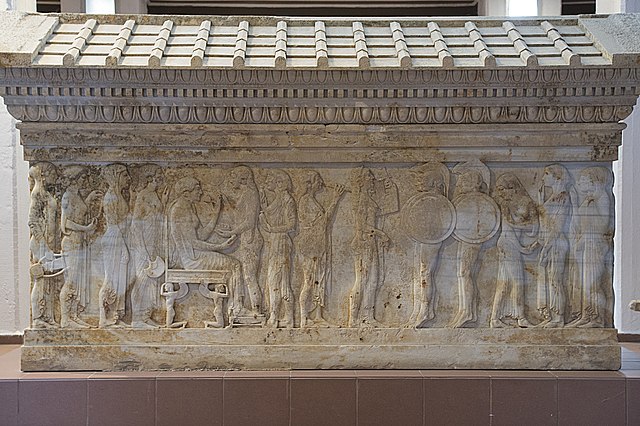In Greek mythology, Hector is a Trojan prince, and a hero and the greatest warrior for Troy during the Trojan War. He is a major character in Homer's Iliad, where he leads the Trojans and their allies in the defense of Troy, killing countless Greek warriors. However, he is ultimately killed in single combat by the Greek hero Achilles, who later drags his dead body around the city of Troy behind his chariot.
Fifth century BC depiction of Cassandra offering Hector libations before he goes into battle.
Cassandra (center) drawing lots with her right hand predicts the downfall of Troy in front of Priam (seated, on the left), Paris (holding the apple of discord) and a warrior leaning on a spear, presumably Hector. Fresco in Pompeii, 20-30 AD
Fresco of Cassandra's prophecy with the presence of presumably Hector, Pompeii
Coin from Troy, 177–192 AD; Obverse: Bust of Commodus; Reverse: Hector, brandishing shield and spear, on a two-horse chariot; ΕΚΤΩΡ (Hektor) inscribed above, ΙΛΙΕΩΝ (Ilion, "Troy") in exergue
The Trojan War was a legendary conflict in Greek mythology that took place around the 12th or 13th century BCE. The war was waged by the Achaeans (Greeks) against the city of Troy after Paris of Troy took Helen from her husband Menelaus, king of Sparta. The war is one of the most important events in Greek mythology, and it has been narrated through many works of Greek literature, most notably Homer's Iliad. The core of the Iliad describes a period of four days and two nights in the tenth year of the decade-long siege of Troy; the Odyssey describes the journey home of Odysseus, one of the war's heroes. Other parts of the war are described in a cycle of epic poems, which have survived through fragments. Episodes from the war provided material for Greek tragedy and other works of Greek literature, and for Roman poets including Virgil and Ovid.
The Golden Apple of Discord by Jacob Jordaens
The Burning of Troy (1759–1762), oil painting by Johann Georg Trautmann
Polyxena Sarcophagus in Troy Museum
The Judgement of Paris (1599) by Hendrick van Balen the Elder. Gemäldegalerie, Berlin








